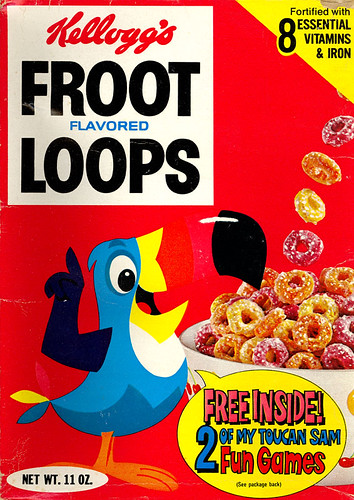
This study confirms what researchers have known for ages now it seems - the attractive characters associated with a product cause children to rate its taste higher.
Here is the press release from JAMA's Archives of Pediatrics & Adolescent Medicine.
CHICAGO—The use of media characters on cereal packaging may influence children's opinions about taste, according to a report in the March issue of Archives of Pediatrics & Adolescent Medicine, one of the JAMA/Archives journals.And here is the abstract for those who are interested."The use of trade (e.g. Ronald McDonald) and licensed (e.g. Shrek) spokescharacters is a popular marketing practice in child-directed products because the presence of these figures helps children identify and remember the associated product," the authors write as background information in the article. Because children remember nonverbal representations more easily than verbal descriptions, a visual cue such as a character or logo, may help them remember information presented in an advertisement.
Matthew A. Lapierre, M.A., and colleagues at the University of Pennsylvania, Philadelphia, evaluated 80 children between the ages of 4 and 6 years (average age 5.6 years), to determine if using a licensed spokescharacter on food packaging affected children's taste assessment of the cereal. Children were shown boxes of cereal labeled either Healthy Bits or Sugar Bits, with some boxes featuring media characters and some without. Having seen only the box, participants were asked to rate the taste of the cereal on a scale of one to five.
Almost all the children reported liking the cereal, however those who saw a popular media character on the box reported liking the cereal more than those who viewed a box without a character on it. Additionally, those who sampled the cereal named Healthy Bits reported enjoying the cereal more than children who were given the same cereal under the name Sugar Bits. Children receiving the cereal with the name Sugar Bits in a box with no characters on it reported being significantly less satisfied with the taste than those in the other three groups. No significant differences were found among children in the Healthy Bits group based on the presence or absence of characters on the box.
"The results of this experiment provide evidence that the use of popular characters on food products affects children's assessment of taste," the authors conclude. "Messages encouraging healthy eating may resonate with young children, but the presence of licensed characters on packaging potentially overrides children's assessments of nutritional merit."
Influence of Licensed Spokescharacters and Health Cues on Children's Ratings of Cereal Taste
Matthew A. Lapierre, MA ;Sarah E. Vaala, MA ;Deborah L. Linebarger, PhD Arch Pediatr Adolesc Med. 2011;165(3):229-234. doi:10.1001/archpediatrics.2010.300
Objective To investigate whether licensed media spokescharacters on food packaging and nutrition cues affect young children's taste assessment of products.
Design In this experimental study, children viewed 1 of 4 professionally created cereal boxes and tasted a "new" cereal. Manipulations included presence or absence of licensed cartoon spokescharacters on the box and healthy or sugary cereal name.
Setting Shopping center in a large northeastern city in December 2007.
Participants Eighty children (mean [SD] age, 5.6 [0.96] years; 53% girls) and their parents or guardians.
Main Exposure Licensed cartoon characters and nutrition cues in the cereal name.
Outcome Measures Children rated the cereal's taste on a 5-point smiley face scale (1, really do not like; 5, really like).
Results Children who saw a popular media character on the box reported liking the cereal more (mean [SD], 4.70 [0.86]) than those who viewed a box with no character on it (4.16 [1.24]). Those who were told the cereal was named Healthy Bits liked the taste more (mean [SD], 4.65 [0.84]) than children who were told it was named Sugar Bits (4.22 [1.27]). Character presence was particularly influential on taste assessments for participants who were told the cereal was named Sugar Bits.
Conclusions The use of media characters on food packaging affects children's subjective taste assessment. Messages encouraging healthy eating may resonate with young children, but the presence of licensed characters on packaging potentially overrides children's assessments of nutritional merit.
Author Affiliations: Annenberg School for Communication, University of Pennsylvania, Philadelphia.
Full citation:
Lapierre, MA, Vaala, SE, Linebarger, DL. (2011, March 7). Influence of Licensed Spokescharacters and Health Cues on Children's Ratings of Cereal Taste. Arch Pediatr Adolesc Med, 165(3):229-234. doi:10.1001/archpediatrics.2010.300
No comments:
Post a Comment